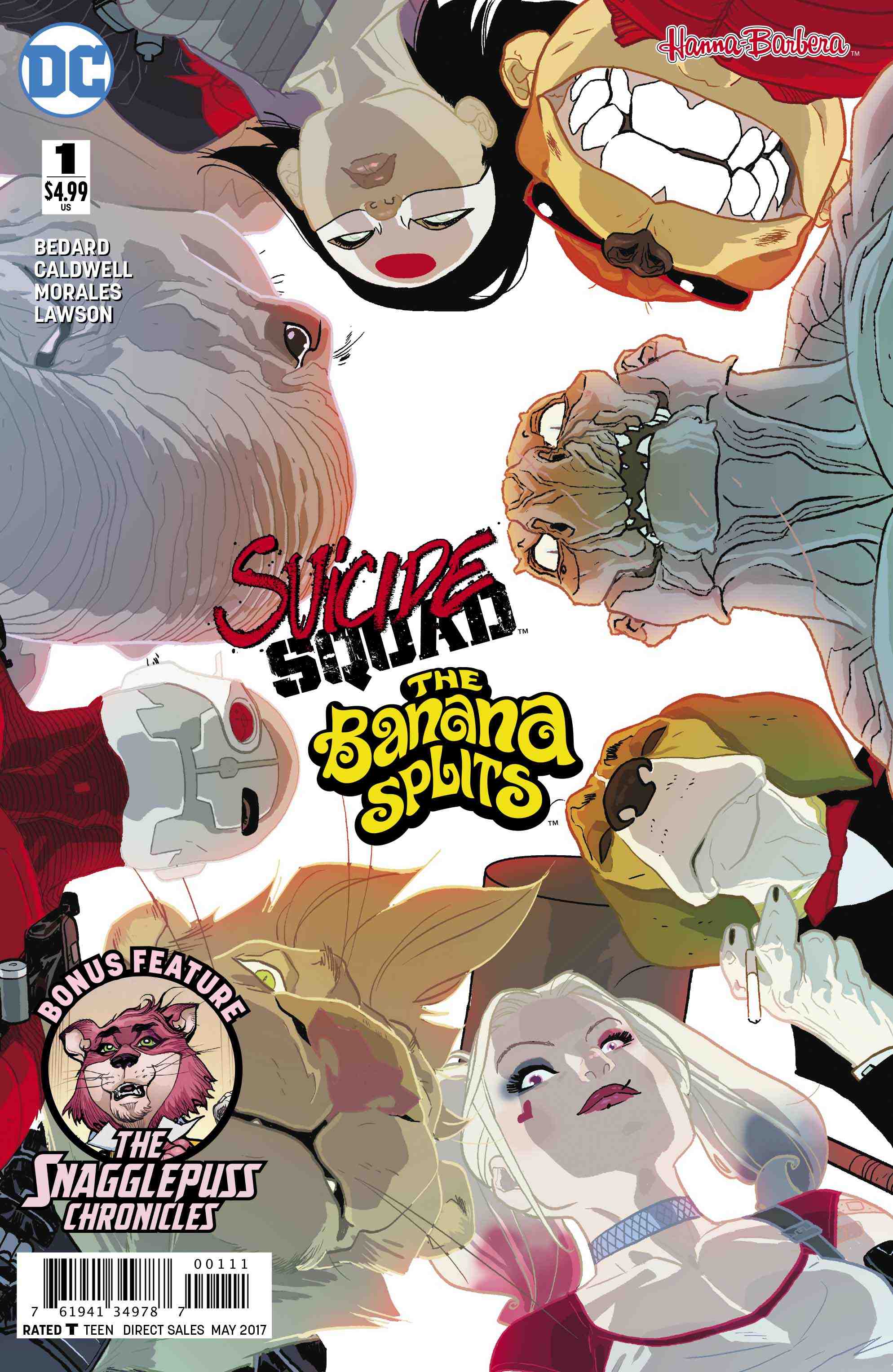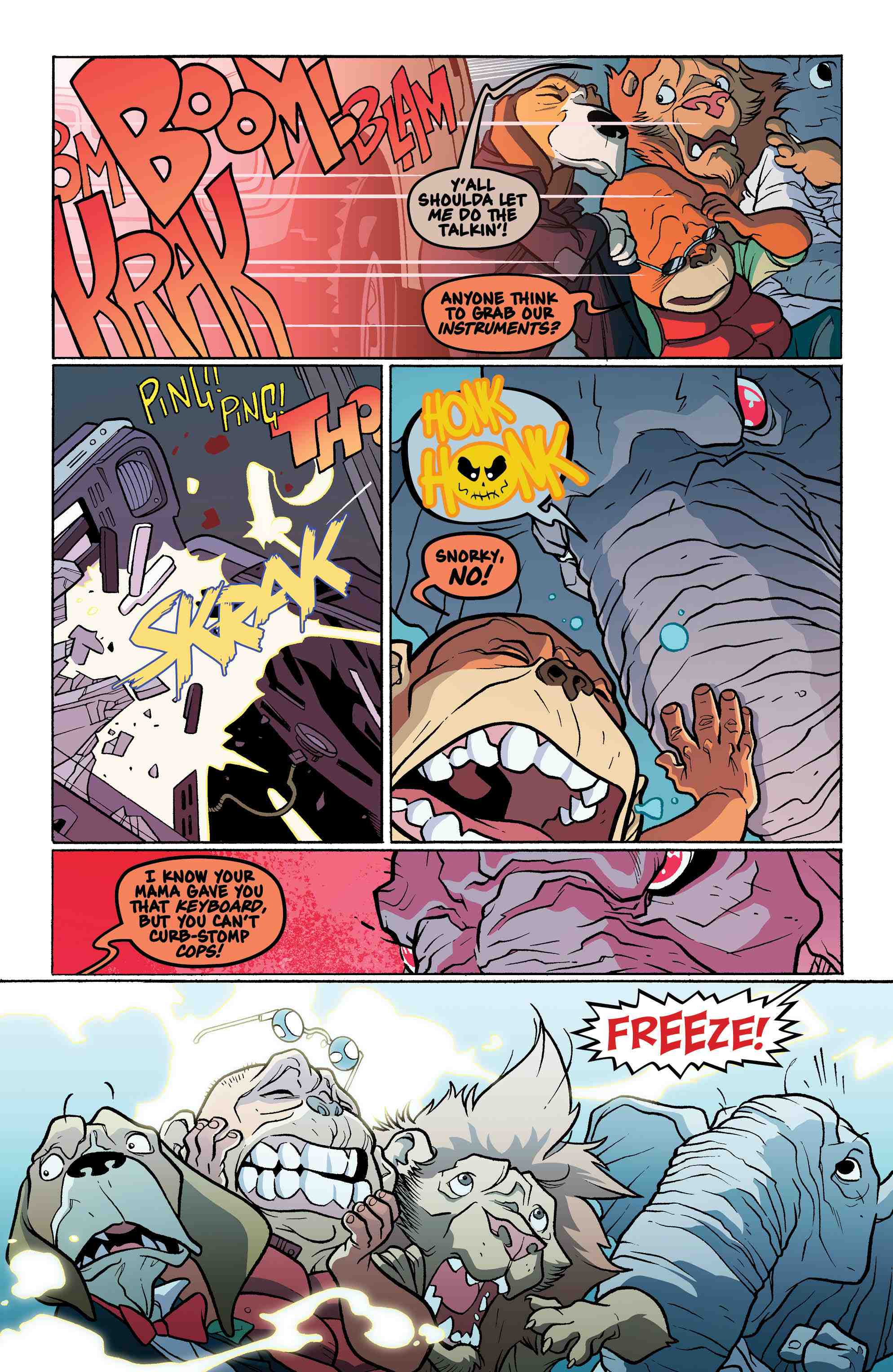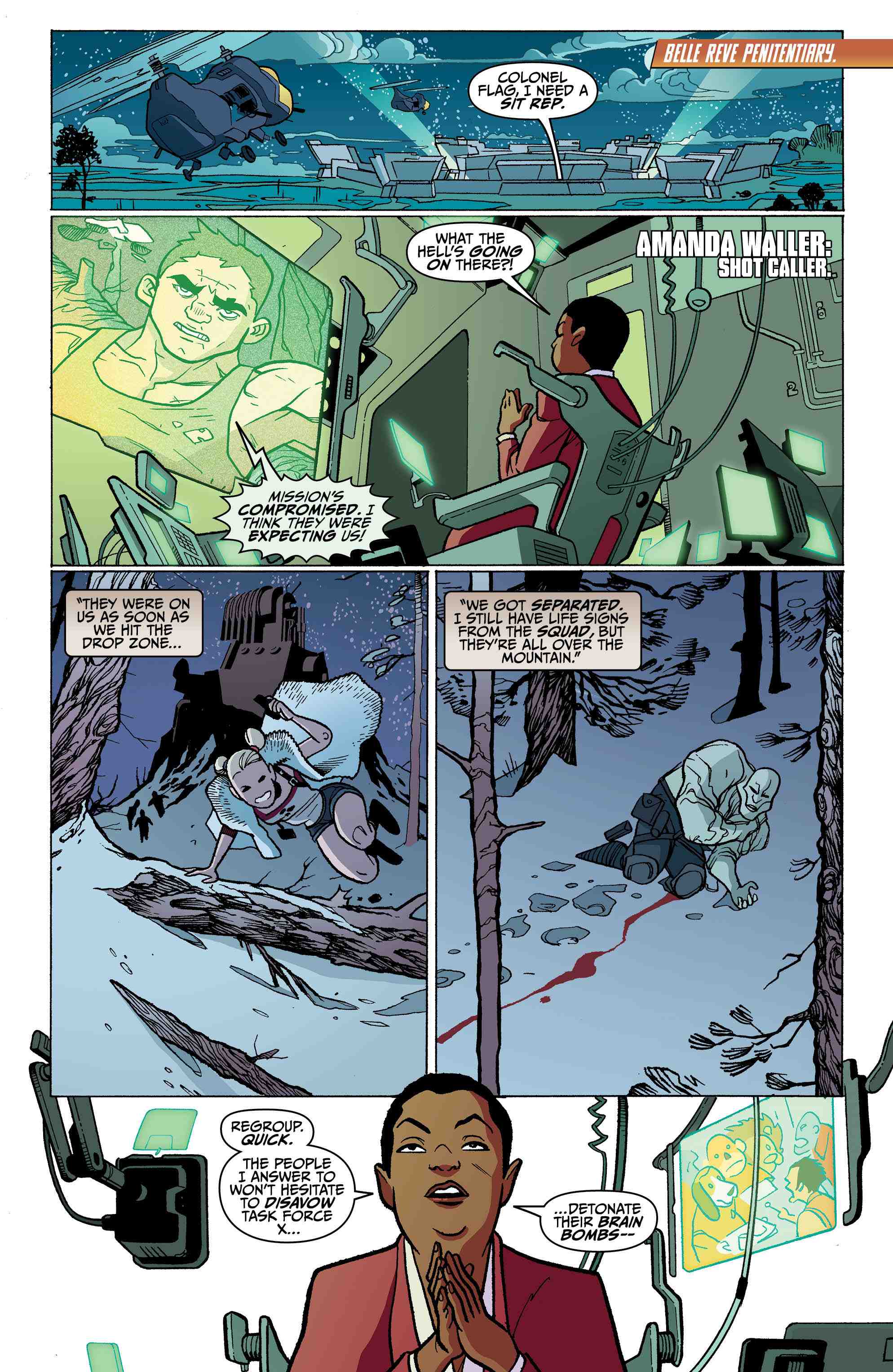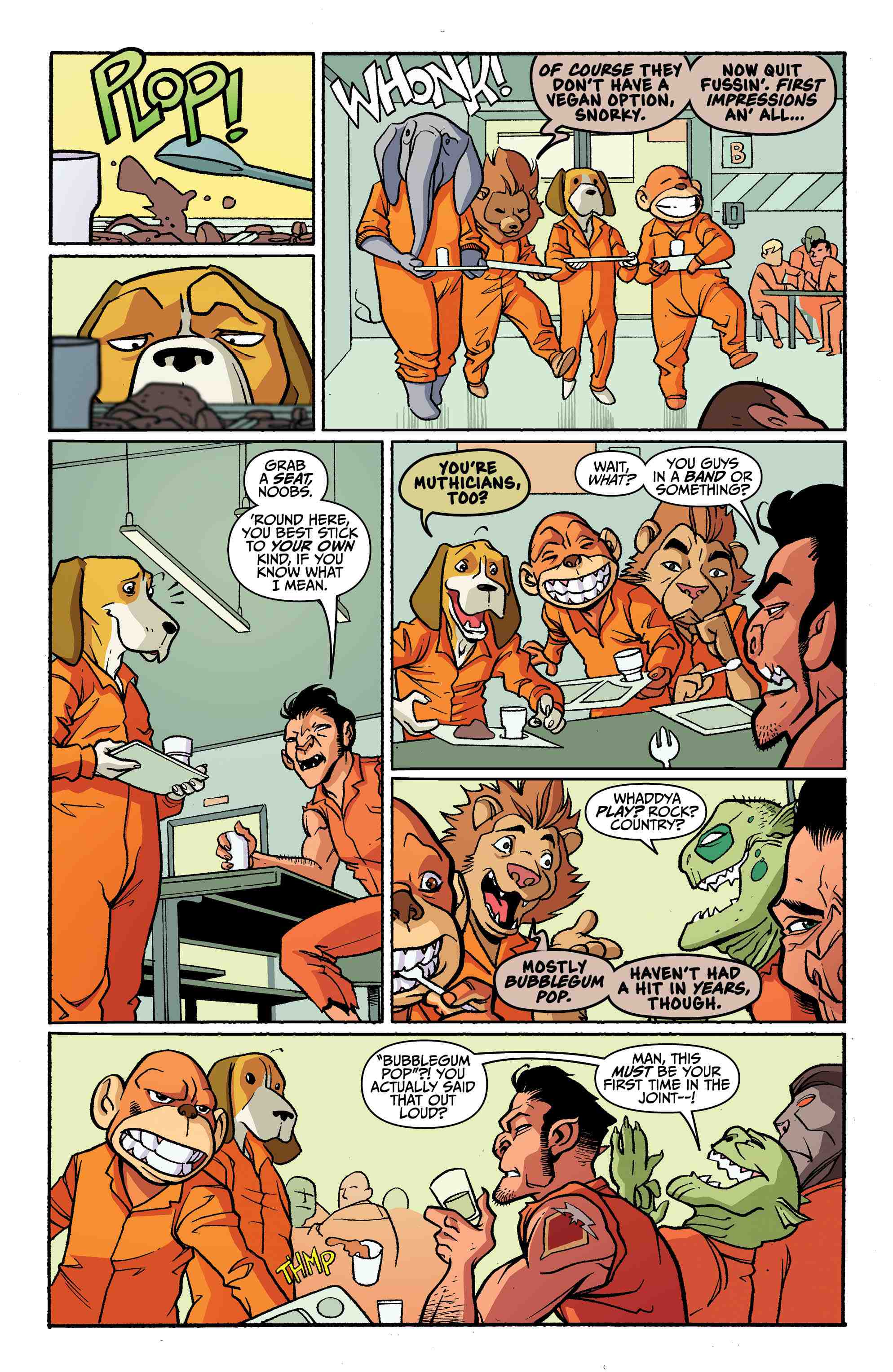[Editor’s Note: This review may contain spoilers.]
 “Suicide Splits” (30 pages)
“Suicide Splits” (30 pages)
Writer: Tony Bedard
Artists: Ben Caldwell (p), Mark Morales (i)
“House Fires” (8 pages)
Writer: Mark Russell
Artists: Howard Porter
Summary
A quartet of anthropomorphic musicians is sent to prison for a crime they did not commit. These rockers promptly escape from a maximum security stockade into the Los Angeles underground where today they survive as soldiers of fortune. If you’re in trouble, if nobody else can help, and if . . .
. . . oh, wait, that’s somebody else.
Okay, here’s the thing — this foursome doesn’t even get to the conviction stage. They just go straight from mistaken arrest to Belle Reve, where nobody seems particularly phased by the fact these guys have animal heads. But, hey, it’s the DC Universe, there’s lots of strangeness walking around. It’s kinda like the CW Supergirl show: “You’re an alien! And you’re an alien! You’re ALL aliens!!”
But the thing is, Amanda Waller happens to be in need of new cannon fodder as the Suicide Squad is on the ropes against some unspeakable horror. So, when the Splits get into a prison fight and end up kicking das booty, Waller’s all, like, ya know what, those guys.
Of course, the Banana Splits know more about bubble gum pop than pop guns, which becomes quickly evident with their Right Stuff slo-walk turns nearly turns the group into a trio. But they look funny, so who’s gonna miss ’em? And in to the drop zone they go, no training needed. Ya sorta hate to see what Waller would do when she’s really desperate for help.
 The Splits get split up during the drop (HA! See what I did there?), but each manages to land about 10 feet from a Suicide Squad member, who had also become separated. Lucky that, eh? And the pairings that follow we learn the unstoppable force which nearly decimated the Squad is . . . . GASP! The Sour Bunch Gang!!
The Splits get split up during the drop (HA! See what I did there?), but each manages to land about 10 feet from a Suicide Squad member, who had also become separated. Lucky that, eh? And the pairings that follow we learn the unstoppable force which nearly decimated the Squad is . . . . GASP! The Sour Bunch Gang!!
Okay, it’s not the gang. It’s actually a horde of death-bots made to look like little girls — a D.E.O. anti-metahuman weapons system, we’re told — code named “Sour Grapes.”
From there, the Squad — Harley Quinn, Deadshot, Katana, and Killer Croc — team up with the Splits to storm the Sour Grapes stronghold and rescue Rick Flag, from whom the prepubescent pulverizers are attempting to coerce a series of missile codes. Eventually, the day is saved, as they say, and cleared of all charges (what charges?) the Banana Splits parlay their newfound street cred into a name change (Banana Splitz) and a second coming as rap artists.
There’s also a back-up story in which Snagglepuss testifies before a House Un-American Committee, which segues into his origin story, with both ends of tale becoming object lessons in how neither politicians, not artists, should take themselves too seriously.
Positives
In storytelling, there’s such a thing as telling too much of the story. Now, granted, in some cases the background is required. For example, in order to truly understand Superman’s character as he flies around Metropolis being all super and stuff, it’s necessary to have at least a passing familiarity with his upbringing in Smallville. And, yeah, you may bitch about having to witness the Waynes get murdered every other issue and three times per movie, but you think Batman isn’t reliving that moment in his mind 100 times a day, every day? It’s his thing. It’s absolutely central to who he is and all his motivations. So, yeah, gotta go there.
But I will tell you that Wolverine was a much more interesting character when we had no idea how old he really is, or even what the Weapon X program was, exactly. And be honest, you don’t really want to know the origin story for Heath Ledger’s Joker — you only think you do.
So, here, whether by accident or design, writer Tony Bedard hits exactly the right mark by sidestepping how the Banana Splits came to be in the DCU. In fact, he tales a play out of Ledger’s laugh log by giving at least two possible origins for the group. Which is true? Either? Neither? Both??
 Bedard also seems to sense — again, either by accident or design — the power of compression. Yeah, the opening scene where the Spits get arrested takes six pages, while being in prison long enough to get noticed by Waller chews up six more. So, good thing this is an extra-sized book. But that panel time is important to establish the characters. And keep in mind, Bedard isn’t telling us who the Splits are in terms of an origin, although he does give us all the traits we need to get who each member is. What he’s doing is establishing that they exist. And, by seeing Waller, the prisoners of Belle Reve, and the cops and jail guards take these animal totems at face value, you, the reader are able to do so as well. That’s important ground to cover before the Splits start interacting with the Suicide Squad who, let’s face it, are themselves more than a little over the top.
Bedard also seems to sense — again, either by accident or design — the power of compression. Yeah, the opening scene where the Spits get arrested takes six pages, while being in prison long enough to get noticed by Waller chews up six more. So, good thing this is an extra-sized book. But that panel time is important to establish the characters. And keep in mind, Bedard isn’t telling us who the Splits are in terms of an origin, although he does give us all the traits we need to get who each member is. What he’s doing is establishing that they exist. And, by seeing Waller, the prisoners of Belle Reve, and the cops and jail guards take these animal totems at face value, you, the reader are able to do so as well. That’s important ground to cover before the Splits start interacting with the Suicide Squad who, let’s face it, are themselves more than a little over the top.
But what Bedard does is skip over the necessary parts. Sure, it’s not really clear why the Splits got pulled over — I suppose their arrest, with the “open season on animal-Americans” line is supposed to be an allegory for Black Lives Matter — and it makes no sense if one lingers on it too long that the Splits would go straight to Belle Reve. The line about Bingo and Drooper missing their shades makes it appear the prison scene comes right after their initial booking, but there would be weeks and months of court appearances and pleas, even if the guys were not out on bail, before the trial and a trip to a maximum security lock-up like Belle Reve. And the chances the gang would still walk into the new home as a group by that point is nil. But Bedard doesn’t give us the long road to conviction, just as Shakespeare doesn’t give too much thought to Rosencrantz and Guildenstern when they’re not busy moving the plot, or being dead. So, boom, skip, Bedard passed over all of the jurisprudence, because none of it matters.
Or, to put it another way, please hum a few bars with me: “If you’re wondering how he eats and breathes, and other science facts, la, la, la . . . “
All that matters is establishing the Banana Splits as part of this world — and amongst the Belle Reve population comics fans wouldn’t bat an eye at, they fit right it — so that when they finally meet the Suicide Squad the reader is ready to accept that the Squad accepts them, no questions asked. Otherwise, the Squad being the grim ‘n’ gritty crew they are, one would have to wonder why Deadshot didn’t put a bullet in Fleegle the dog-faced boy on first sight.
And so, even though the Suicide Squad doesn’t appear until halfway through the book, we’re able to just sit back and enjoy the mayhem once the team-up really kicks into gear.
And I have to say, the entire thing is a sight to behold. Ben Caldwell tells the story well and his work here is cartoony enough to capture the humor and spirit of everything that goes on, but not so broad or stylized that it doesn’t feel “real.” In fact, it’s interesting that the opening scenes have almost more realism to them than the ones that follow after the Squad enters the stage.
I’m not sure how old Bedard is. I’m guessing older than me, and while I’m 49, that means the Banana Splits was well into re-runs before I encountered them as a kid. But he gets the characters mostly right. He knows the Sour Grapes never had any lines, and that neither did Snorky. Snork’s iconographic honks are a hoot, though. His depiction of Fleegle as slightly more upper-crust than the others (is his own mind, at least) and his disdain for actual fisticuffs, while seemingly new additions, are in keeping with what we know of the character. After all, he was the only one of the group to wear a tie, and he was usually busy trying to chair their club meetings while the others were busy rough-and-tumbling all over each other.
 Negatives
Negatives
My only negatives are real nitpicks. For example, the American flags on the sleeves of Snorky’s uniform are backwards. It’s the flag on the right arm that’s flown “backwards.” I’d say an editor should have caught that, but it could be some form of meta-commentary from Snork, or Bedard, for all I know.
I also was taken out of the story here and there by Bingo, who was depicted with expressions more highly caricatured than the rest. If we’re going to do most Splits as a semi-realistic depiction, they should all be done that way. He looked almost like his TV self most of the time.
On that note, I was able to accept the different depictions here, even for Snorky. On the TV show he’s the most diminutive of the bunch, whereas here him big like ellie-phant. But I figured, if the Splits were real, and got a cartoon show, some television executive should surely demand the studio do a Hamburglar on the big, scary pachyderm.
Finally, I didn’t love the final joke, if only because, hey, I happen to like bugglegum pop!
Oh, and the Snagglepuss story . . . meh. It was a little too earnest and on-point for me. I liked it better as a contrast to the zaniness of the main story than as a thing unto itself, and I’m sort of glad this was done as a back-up story and not as a re-imagined book unto itself.
Verdict
So, the verdict, you want to know what I thought, right? LOVED it!
Now, I say that admitting I came in fully prepared to hate this book. In fact, based on the cover alone, I was was intending to have a snark-hurling meltdown of biblical proportions. Oh, yeah. I was expecting to take the “You’ve raped by childhood!” wails the internet made at Scooby Apocalypse and turn the screech on that whaaaa-mbulance all the way up to 11. After all, keep in mind that The Banana Splits was a huge part of my formative years. Yeah, it was into re-runs by the time I was in Grades 1-4, but it was on every afternoon when I, as a latchkey kid, got home from school. So, “Uh-oh, Chongo,” I watched a LOT of Banana Splits. But with the redesigns seen on the cover solicitation, and the fact that the Suicide Squad hasn’t been my thing in any incarnation since the classic ’80s run, I just felt certain I was going to hate this book.
But instead, as I said — loved it.
I thought this issue gave a modern DCU take on the characters that did not despoil or belittle them — that it was funny, without making fun.
And I’ll say this — word is DC is going to try again with a second round of Hanna-Barbera remakes. If this version of The Banana Splits, by this issue’s creators, is in that mix, I will most definitely pony up my hard-earned cash every month for some of that.
